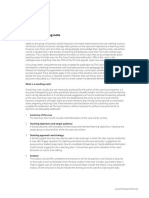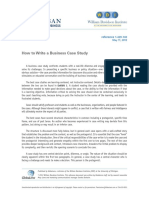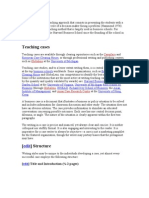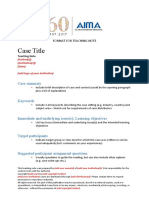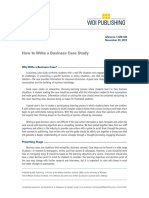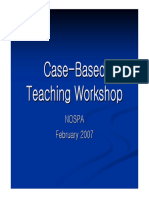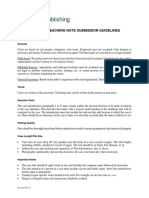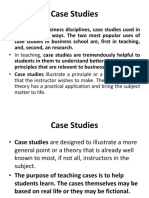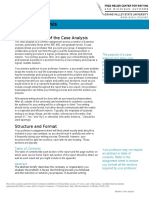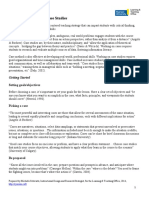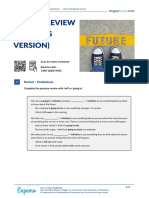WRITING TEACHING CASES: A QUICK REFERENCE GUIDE
Ali Farhoomand
The University of Hong Kong
ali@business.hku.hk
ABSTRACT
Writing a teaching case is different from writing a research article. This short guide explains
what is involved in writing a good teaching case. More specifically, it describes how to
increase the teaching value of a case by linking it to pertinent theories and concepts, how to
make a case more appealing to students through contextual nuances, and how to write useful
teaching notes.
Editor’s Note: This editorial was prepared by Prof. Ali Farhoomand of the University of The University of
Hong Kong. He observed that authors are not preparing cases in a form suitable for classroom use. He
therefore prepared this brief guide to assist authors so that the time between submission and publication
is speeded.
INTRODUCTION
The case method is a powerful approach to teaching and learning business subjects. It’s main
advantage is that it is a “question-oriented”, as opposed to solution-based, approach to
teaching and learning. It allows students to participate in “real-life” decision making processes
by first identifying the major “question” in the case before formulating appropriate solutions.
Writing a teaching case is more similar to writing a spy thriller than a research article. To
begin with, a case has to have a hook: an overriding issue that pulls various parts together, a
managerial issue or decision that requires urgent attention. The trick is to present the story
such that the hook is not easily evident but “discovered” by students by putting relevant
pieces together. More importantly, the hook must be linked to a particular concept, theory, or
methodology.
Before starting to write a case, first think of several important “design” questions:
1. What theories or concepts are you going to teach through the case?
2. Are there any interesting hook(s) that can bind the story together?
104 Communications of the Association for Information Systems (Volume 12, 2003)103-107
Writing Teaching Cases: A Quick Reference Guide by A. Farhoomand
3. Is the case sufficiently rich in terms of contextual nuances (the setting, personalities,
cultures, urgency of issues)?
4. How would students react to the case? Is it sufficiently challenging? Interesting?
5. Is there enough dynamic tension in the case to produce contentious and competing
views?
6. Would the case lend itself to an interesting and useful teaching and learning approach
(e.g., role playing, simulation)?
A case typically consists of three main parts.
Part 1. The Opening Paragraph
In the opening paragraph, invariably the most important part of a case, you set the general
scene and tone. It is not a summary, and is different from the abstract of a research article.
Use the opening paragraph to paint a concise and interesting picture of the main issue(s) in
the case; describe the context within which the case occurs; introduce the principal
protagonist(s); set the timeline. It is customary to finish the opening paragraph with one or two
overriding questions facing the characters in the case.
�The opening paragraph should provide a summary of the five questions posed by journalists:
• what • who • why• where • when
Part 2: Body of the Case
The second part, the body of the case, is used to tell the whole story -- usually in a
chronological order. It typically contains general background on business environment,
company background, and the details of the specific issue(s) faced by the company.
Paying attention to contextual shades is particularly important at this stage. How you tell the
story is often more important than the story itself. A good case should exude dynamic tension.
Tell more than one side to the story so that students can think of competing alternatives. A
good case usually revolves around at least one major issue that is usually simple to identify
but not necessarily easy to resolve. Engage the reader by using quotations from interviewees
or stakeholders of the case.
Part 3. Concluding Paragraph
In the last part, the concluding paragraph, provide a short synthesis of the case to reiterate
the main issues, or even to raise new questions.
Principles
• Use simple and clear English to avoid clutter [Zinsser, 1998].
• Write neutrally. As a case writer, you should play the role of an honest investigative
journalist without “taking sides”.
• Don’t provide any analysis, or “lessons learned” in the case; leave that in the teaching
note. Communications of the Association for Information Systems (Volume13, 2004)103-107 105
Writing Teaching Cases: A Quick Reference Guide by A. Farhoomand
• Let students decide about the merits of any particular argument based on their
understanding of the facts provided in the case.
• Embellish to highlight or downplay certain points, but stay true to the facts.
Purely descriptive cases provide a snapshot of an interesting issue, but they usually are of
limited academic value. Description (what) is only the first stage in the learning process. A
bona fide teaching case should be, at a minimum, decisional and analytical. It should
challenge students to move to higher orders of learning by prompting them to ask “how” the
issues are related to one another and “why” things happen the way they do. By learning how
to identify business patterns, students can improve their analytic skills.
Characteristics of a Good Case
A good case should give enough information so that students can break down the relevant
facts. But it mustn’t provide any diagnosis or prognosis.
A good case should challenge students to make a “business case” for a particular decision by
articulating how and why they came up to their decision.
A good case should provoke students to think laterally.
A good case should ideally promote both analysis and synthesis skills. Students usually learn
quickly how to break down a case into clusters of related issues; they are mostly good at
analysis. They have more difficulty, however, with synthesis -- how to put related facts into a
coherent, articulated plan of action.
�A good Information systems case often involves implementation issues. Take advantage of
these issues to increase dynamism by highlighting the human and socio-political factors in
implementation.
HOW TO WRITE A CASE1
1. Teaching cases tell a story about what happened. They should therefore be written in the
past tense.
2. Identify and establish an issue/problem which can be used to teach a concept or theory.
3. The opening paragraph of the case should typically contain the following information:
• WHOSE role is the student to assume?
• WHO is the key decision maker?
• WHAT is the nature of the issue/problem?
• WHEN did the case take place? Specify the date line in this paragraph.
• WHERE did the case take place; what organization?
• WHY did the issue/problem arise?
4. Establish teaching objective(s) and revise the opening paragraph as necessary:
• Specify the purpose of writing the case.
• Check if the opening paragraph matches the purpose.
• Check if the case is appropriate for the course for which it is intended.
• Check if the case is appropriate for teaching the relevant concepts/theories.
5. Structure the case and decide on subheadings
HOW TO WRITE TEACHING NOTES
Generally speaking, teaching notes should convey what the student is to accomplish at the
end of the case. They are designed to provide the instructor with a general understanding of
the case content, objectives, key issues or questions, and suggested teaching approaches of
the case.
Additional information such as financial data and exhibits may be included to increase the
level of difficulty of the case. Teaching notes should be written concurrently with the case.
Unlike the case, which is written in past tense, teaching notes should be written in the present
tense because they are the writer’s current analysis of issues raised in the case. They may
include:
• Potential uses of the case
• Potential audience of the case
• Teaching objectives
• Suggested teaching approach/plan
• Case description/synopsis of the case
• Immediate use(s) of the Case
• Basic issue(s)
• Possible discussion questions
• Suggested student assignments
• Suggested additional readings or references
• Analysis
• Computer and multi-media support, if any.
• Teaching themes and lessons from the case
CONCLUSION
A good teaching case encourages lateral thinking by unraveling the dynamic interplay
between the inductive and deductive methods of discovery. As business issues increasingly
become more complex and interdependent, it is important for business students to
�• learn how to differentiate between major and minor issues,
• discover business patterns,
• distinguish problems from symptoms, and
• synthesize their thoughts into coherent, articulated and actionable decisions.
It is important to write teaching cases in such way that students learn that there is no “one
solution” to business problems and that tradeoffs are possible among competing alternatives.
Communications of the Association for Information Systems (Volume13, 2004)103-107 107
Writing Teaching Cases: A Quick Reference Guide by A. Farhoomand
The ability to make tradeoffs, and communicate the logic behind such tradeoffs, enhances
students’ strategic orientation in dealing with business issues.
REFERENCES AND ADDITIONAL READINGS
Leenders, M. R., Mauffette-Leenders, L. A., Erskine, J. A., (2001), Writing Cases, (Fourth
Edition), Ontario, Canada, Ivey Publishing, Richard Ivey School of Business, The University of
Western Ontario.
Leenders, M. R., Mauffette-Leenders, L. A., Erskine, J. A., (1998), Teaching with Cases,
Ontario,
Canada, Ivey Publishing, Richard Ivey School of Business, The University of Western
Ontario.
Leenders, M. R., Mauffette-Leenders, L. A., Erskine, J. A., (1997), Learning with Cases,
Ontario,
Canada, Ivey Publishing, Richard Ivey School of Business, The University of Western
Ontario.
Zinsser, W., (1998), On Writing Well: The Classic Guide to Writing Nonfiction, (Sixth Edition),
New York, HarperCollins Publishing.
ABOUT THE AUTHOR
Ali Farhoomand is Director of Centre for Asian Business Cases (CABC) at The University of
Hong Kong. He is the author of over 70 case studies related of information systems, which
can ordered through Harvard Business School, the European Case Clearinghouse and the
CABC(www.cabc.org.hk). Ali is the author of Global e-Commerce: Text and Cases (Prentice
Hall,2001) and Managing e-Business Transformation (Palgrave/Mcmillan, 2004).
Copyright © 2004 by the Association for Information Systems. Permission to make digital or hard copies
of all or part of this work for personal or classroom use is granted without fee provided that copies are
not made or distributed for profit or commercial advantage and that copies bear this notice and full
citation on the first page. Copyright for components of this work owned by others than the Association
for Information Systems must be honored. Abstracting with credit is permitted. To copy otherwise, to
republish, to post on servers, or to redistribute to lists requires prior specific permission and/or fee.




